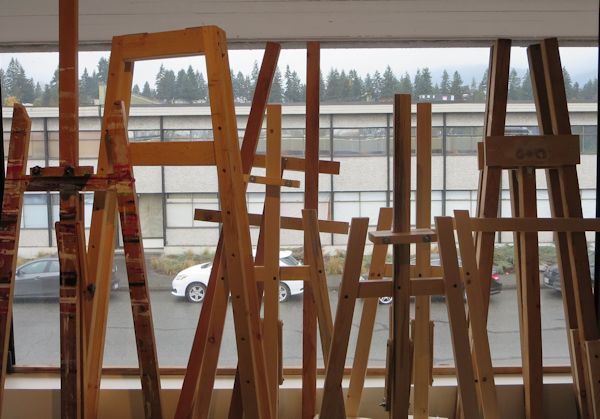Did you know the word easel comes from the Dutch word “ezel,” which means donkey. By association of ideas, the word donkey came to designate the easel and its relative, the drawing donkey. Easels are a basic art tool that come in many varieties, materials, sizes and prices points.

Your easel might be one of the most expensive pieces of equipment you will have to buy as an artist, and you’ll likely spend most of your painting or drawing time using it, so you’ll want it to be comfortable. Before making the investment, it’s a good idea to learn about the different types of easels and what they are designed for.
Wondering how to choose an easel? First, consider the use you will make of it. Here are some factors that may influence your choice:
1. What medium are you working with?
If you are creating mixed media artwork, or working with watercolors, fluid acrylics, or anything very liquid, you will want to work most of the time horizontally or at a very low angle. There are some watercolor easels that will allow you to adjust the angle at which you are working and let you paint in a horizontal position, but you have also the option of working on a table.

If you are painting with a medium that may run, you might prefer working on a table instead of an easel.
For other types of media, the easel has the advantage of making you work on a plane that is parallel to what you are painting, especially if you are working from life.
If you are a pastel artist, for instance, you will want your painting in a vertical or tilted forward position so the dust can fall away from your painting.
Most easels will work for acrylic or oil. Working vertically will prevent dust from depositing on the wet paint, which is important especially for oil painters since oil paint takes longer to dry than acrylic.

A-frame easels are suitable for life drawing.
If your easel will be used mainly for life drawing, you can choose a light easel with tripod legs, also called an A-frame easel, as you will need to hold mainly paper and it will be easy to fold and carry around.

The sketch box easel can be conveniently folded and will carry your painting supplies.
2. Are you working inside the studio or are you going to do some plein air painting?
If you are going to stay in the studio, you can go with an easel that is heavier and bigger, working en plein air will require a lighter, more portable easel. You might consider a sketch box easel if painting outside, as it will allow you to store your painting materials in the box that comes attached to this kind of easel.

A table easel doesn’t require a lot of space and can easily be folded.
3. How much space do you have?
If your space is limited and you are not painting very big canvases, you might want to choose a table easel, as floor standing easels will require more space.

An H-frame easel is very stable, can hold big canvases, and won’t move too much even if you paint vigorously.
4. What is your painting style and how big do you like to work?
If you have a heavy hand and like to work big, you will need a sturdier floor standing easel and might consider a more stable H-frame easel. Of course, the bigger and sturdier the easel, the more expensive it will get.
If you have a very delicate painting style and are working with small canvasses, then a table standing or an A-frame easel should work.
Display easels are designed to display work and might not be sturdy enough to work.

Share tips, start a discussion or ask one of our experts or other students a question.
No Responses to “Fine Art Friday: How to Choose an Easel”